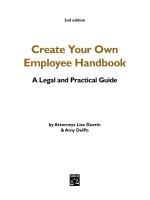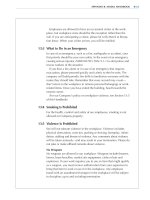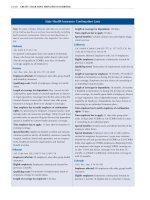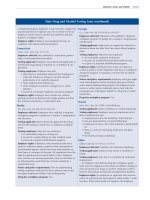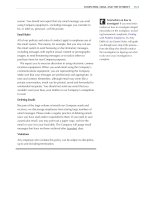create your own hedge fund increase profits and reduce risks with etfs and options phần 1 pptx
Bạn đang xem bản rút gọn của tài liệu. Xem và tải ngay bản đầy đủ của tài liệu tại đây (2.46 MB, 26 trang )
TeAM
YYePG
Digitally signed by TeAM YYePG
DN: cn=TeAM YYePG, c=US, o=TeAM
YYePG, ou=TeAM YYePG,
email=
Reason: I attest to the accuracy and
integrity of this document
Date: 2005.01.22 12:37:16 +08'00'
Create
Your Own
Hedge
Fund
4339_P FM.qxd 11/19/04 12:14 PM Page i
Founded in 1807, John Wiley & Sons is the oldest independent publishing
company in the United States. With offices in North America, Europe, Aus-
tralia, and Asia, Wiley is globally committed to developing and marketing
print and electronic products and services for our customers’ professional
and personal knowledge and understanding.
The Wiley Trading series features books by traders who have survived the
market’s ever-changing temperament and have prospered—some by rein-
venting systems, others by getting back to basics. Whether a novice trader,
professional, or somewhere in between, these books will provide the ad-
vice and strategies needed to prosper today and well into the future.
For a list of available titles, visit our web site at www.WileyFinance.com.
4339_P FM.qxd 11/19/04 12:14 PM Page ii
Create
Your Own
Hedge
Fund
Increase Profits and
Reduce Risk with ETFs
and Options
MARK D. WOLFINGER
John Wiley & Sons, Inc.
4339_P FM.qxd 11/19/04 12:14 PM Page iii
Copyright © 2005 by Mark D. Wolfinger. All rights reserved.
Published by John Wiley & Sons, Inc., Hoboken, New Jersey.
Published simultaneously in Canada.
No part of this publication may be reproduced, stored in a retrieval system, or
transmitted in any form or by any means, electronic, mechanical, photocopying,
recording, scanning, or otherwise, except as permitted under Section 107 or 108 of
the 1976 United States Copyright Act, without either the prior written permission
of the Publisher, or authorization through payment of the appropriate per-copy
fee to the Copyright Clearance Center, Inc., 222 Rosewood Drive, Danvers, MA
01923, 978-750-8400, fax 978-646-8600, or on the Web at www.copyright.com.
Requests to the Publisher for permission should be addressed to the Permissions
Department, John Wiley & Sons, Inc., 111 River Street, Hoboken, NJ 07030,
201-748-6011, fax 201-748-6008.
Limit of Liability/Disclaimer of Warranty: While the publisher and author have
used their best efforts in preparing this book, they make no representations or
warranties with respect to the accuracy or completeness of the contents of this
book and specifically disclaim any implied warranties of merchantability or fit-
ness for a particular purpose. No warranty may be created or extended by sales
representatives or written sales materials. The advice and strategies contained
herein may not be suitable for your situation. You should consult with a profes-
sional where appropriate. Neither the publisher nor author shall be liable for any
loss of profit or any other commercial damages, including but not limited to
special, incidental, consequential, or other damages.
For general information on our other products and services, or technical support,
please contact our Customer Care Department within the United States at
800-762-2974, outside the United States at 317-572-3993 or fax 317-572-4002.
Wiley also publishes its books in a variety of electronic formats. Some content
that appears in print may not be available in electronic books. For more
information about Wiley products, visit our web site at www.wiley.com.
Library of Congress Cataloging-in-Publication Data:
Wolfinger, Mark D.
Create your own hedge fund : increase profits and reduce risk with ETFs and
options / Mark Wolfinger.
p. cm. — (Wiley trading series)
Includes bibliographical references and index.
ISBN 0-471-65507-4 (cloth)
1. Hedging (Finance) 2. Stock options. 3. Exchange traded funds. I. Title
II. Series.
HG6024.A3W65 2005
332.64'524—dc22
2004016625
Printed in the United States of America
10987654321
4339_P FM.qxd 11/19/04 12:14 PM Page iv
This book is dedicated in loving memory to my parents,
Betty and Khiva Wolfinger. They would have loved to see
their son become an author.
4339_P FM.qxd 11/19/04 12:14 PM Page v
4339_P FM.qxd 11/19/04 12:14 PM Page vi
Contents
Acknowledgments ix
Preface xi
PART I Outperforming the Market 1
CHAPTER 1 Modern Portfolio Theory 3
CHAPTER 2 Can You Beat the Market? Should You Try? 9
CHAPTER 3 Hedge Funds 20
PART II Exchange Traded Funds 27
CHAPTER 4 A Brief History of Mutual Funds and
Exchange Traded Funds 29
CHAPTER 5 Traditional Mutual Funds 32
CHAPTER 6 Exchange Traded Funds 38
PART III Options 53
CHAPTER 7 What Is an Option and How Does an Option
Work? 55
CHAPTER 8 More Options Basics 60
vii
4339_P FM.qxd 11/19/04 12:14 PM Page vii
CHAPTER 9 Why Investors Buy and Sell Options 69
CHAPTER 10 Option Strategies You Can Use to
Make Money: Covered Call Writing 80
CHAPTER 11 Option Strategies You Can Use to
Make Money: Uncovered Put Writing 100
CHAPTER 12 Historical Data: BuyWrite Index
and Volatility Index 111
PART IV Putting It All Together 121
CHAPTER 13 Building a Portfolio 123
CHAPTER 14 Finding Your Style: Choosing
an Option to Write 131
CHAPTER 15 Covered Call Writing in Action: A Year of
Trading 141
CHAPTER 16 Uncovered Put Writing in Action 195
CHAPTER 17 Odds and Ends and Conclusion 212
Notes 216
Glossary 227
Index 231
viii
CONTENTS
4339_P FM.qxd 11/19/04 12:14 PM Page viii
ix
Acknowledgments
M
any thanks to my family and friends who provided guidance, sup-
port, encouragement, and great information, particularly Lynn
Seligman, Nancy Crossman, Gail Reichlin, and Camden McKinley.
A special thank you to my life-partner, Penny Rotheiser, whose attention to
detail proved invaluable.
And thank you to all the dedicated people at John Wiley & Sons who
did their jobs well and provided encouragement and answers to my many
questions. Their input made the completion of this project both more en-
joyable and more efficient: Jeanne Glasser, for encouraging me to submit
the book proposal in the first place; editor Kevin Commins; editorial direc-
tor Pam van Giessen; editorial assistant Lara Murphy; editorial assistant
Matt Kellen, who found the help I needed on every conceivable topic; mar-
keting manager Felicia Reid; and production manager Alexia Meyers, who
carefully transformed the raw manuscript into the finished product.
Thank you all.
4339_P FM.qxd 11/19/04 12:14 PM Page ix
4339_P FM.qxd 11/19/04 12:14 PM Page x
xi
Preface
E
veryone wants to make money in the stock market, and each indi-
vidual has reasons for owning stocks. Whatever your motivation—
saving for retirement, saving to provide a college education for your
children or a home for your family, even trying to earn more money so you
can enjoy the good life—making money via investing is the goal of millions
of people all over the world.
Although everyone agrees that making money is the goal, not everyone
agrees on the best way to accomplish that goal. This book introduces you
to a twenty-first-century style of investing that combines the best aspects of
two important investment tools: exchange traded funds (ETFs) and stock
options. You will learn to hedge, or reduce the risk of owning stock.
Most investors who make their own investment decisions overestimate
their results and, if asked, would say their methods produce market-beating
results year after year. They are not exactly failing to tell the truth, because
most believe they can (and should) consistently outperform the market.
And if they didn’t do especially well this past year or two, well, that’s okay,
for they know their performance during the next few years will more than
compensate for any recent underperformance.
The truth is that individual investors, on average, consistently under-
perform the market. That’s sad because many people love making those in-
vestment decisions and being actively involved with trading. If you
currently make all your own investment decisions, this book shows you an
alternative method for handling your investments—a method that reduces
overall risk at the same time it increases your chances of beating the mar-
ket. And for those who enjoy being active traders, this methodology is fun.
There are decisions and trades to make every month, although you can
modify the method to trade less frequently (every three or even every six
months), if that’s your preference.
A great many investors have neither the time nor the inclination to
make their own investment decisions. They feel more comfortable depend-
ing on others, and there are many professional money managers eager to
4339_P FM.qxd 11/19/04 12:14 PM Page xi
take their money and make those investment decisions. These investors,
who ordinarily do meticulous research before spending money on a vaca-
tion, a car, or even a home computer, and who seek every opportunity to
determine which product provides the best performance or which received
the best reviews from consumers, often invest money based on information
gleaned from advertisements that gloat over recent good performance.
They place their future financial security entirely into the hands of people
they haven’t bothered to research thoroughly—specifically, mutual fund
managers. The fund managers who do achieve above-average results ad-
vertise those results to a public eager to invest. Unfortunately, evidence
shows that recent track records bear little resemblance to future results.
It’s impossible to predict in advance who the successful fund managers will
be this (or any) year. But, no matter, there are millions of investors eager to
throw billions of dollars at those fund managers. The question is: Do those
managers perform any better than individual investors? Are they able to
outperform the market year after year? We’ll take at look at the evidence,
but the short answer is no. They perform no better than individual in-
vestors, yet they are not bashful about charging fees to manage investor
money.
The recent scandals involving after-hours trading and allowing favored
customers to buy and sell shares without incurring fees that individual in-
vestors would have to pay make it even more unlikely that mutual fund
managers can provide individual investors with the service they deserve.
Fortunately, there are viable alternatives, and you don’t have to accept
those poor results any longer.
There are several ways a public investor can earn better returns than
are available by entrusting hard-earned savings to professional mutual fund
managers. One simple way is to invest in index funds. At least these funds
make no attempt to beat the market; they are content to match the perfor-
mance of the averages. With fewer commissions and no research, this man-
agement style results in significantly lower annual expenses for the fund,
and the savings are passed on to the investor. Average performance is bet-
ter than underperformance, and paying smaller fees is better than higher
fees.
But indexing, by itself, is not the final answer. There is more an in-
vestor can do to enhance investment returns. This book shows how to ac-
complish that goal.
You will learn to choose an investment advisor who is entirely trust-
worthy and capable of handling all your investment decisions. That advisor
follows the teachings of modern portfolio theory (MPT). That advisor
builds a well-diversified portfolio of stock market investments and man-
ages those investments without charging a fee. That advisor uses methods
that increase the probability of beating the market averages and does so
xii
PREFACE
4339_P FM.qxd 11/19/04 12:14 PM Page xii
with a reduced chance of incurring losses. That’s right: Enhanced earnings
and reduced risk. So where do you find such an advisor? That’s easy: Look
in the mirror. You can make your own investment decisions. You can be
your own fund manager.
There is no magic formula involved, nor some high-risk hocus-pocus.
There are no promises of getting rich in a hurry. The success of this invest-
ment methodology is based on the steady growth of capital that comes
from doing well on a consistent basis. It is based on combining two readily
available investment tools into one cohesive strategy. Exchange traded
funds, the modern version of the traditional mutual fund, and stock options
are the tools used to manage your investment portfolio.
You’ll learn why ETFs are a more efficient investment vehicle than tra-
ditional mutual funds for most individual investors. They have tax advan-
tages, charge lower fees, and essentially match the performance of the
market averages. No more paying fees for underperformance!
Options are a misunderstood investment tool. Options were designed
to reduce investment risk, but too many investment advisors tell their cus-
tomers that options are dangerous and should be used only by speculators.
We’ll clear up that misconception, and you’ll learn to use options to both re-
duce risk and enhance profits.
By combining these two tools into one investment methodology, you
essentially create and run your own hedge fund. And the best part is that it’s
not complicated. You can readily learn to manage your investments your-
self, but if you are a busy professional who believes there is not enough
time to intelligently make your own investment decisions, you can turn the
whole process over to a broker or financial planner you trust to follow your
instructions.
Many investors reaped rich rewards during the strong stock market of the
late 1990s, but a large percentage of those investors gave back all those
profits (and then some) during the ensuing bear market at the beginning of
the new millennium. Many are searching for the elusive holy grail of in-
vesting, namely finding a way to consistently outperform the market aver-
ages with limited risk. This book shows those investors such a path to
financial security. Investors are no longer forced to rely on mutual fund
managers because they don’t feel there is any alternative. The methods
taught here require some effort, but the rewards are worth it.
Investing is not a game. It’s a project that must be taken seriously, as your
future financial independence is at stake. It requires an understanding of
the risks and rewards of investing. Successful individual investors who
make their own decisions devote a great deal of time and effort to avoid
making bad decisions. Some spend countless hours poring over annual re-
Preface xiii
4339_P FM.qxd 11/19/04 12:14 PM Page xiii
ports and 10-k filings in an effort to find companies that have the potential
to earn great profits in the future (fundamental analysis). Others spend
time with charts and graphs, attempting to use price and volume data to
predict future stock prices (technical analysis). If you follow the methods
taught here, you can be spared those hours of research. Individuals, on av-
erage, are not able to find those great companies, and unless you have a
proven track record of consistently outperforming the stock market aver-
ages, it’s less risky to own a diversified portfolio, such as those represented
by ETFs. Those investments can be hedged with options, reducing risk
even further.
The methodology taught in this book does not guarantee profits. But it does
present an investing strategy that increases your chances of being a suc-
cessful investor. It increases the odds that your portfolio outperforms the
market averages on a consistent basis, and it reduces your overall invest-
ment risk. Those are not just idle claims, and statistical evidence is included
to support those claims. The path to investment success discussed in this
book uses neither fundamental nor technical analysis. The recommended
strategy is one that you, an individual investor, can readily adopt for
yourself.
That investment method involves:
• Asset allocation: Determine the portion of your assets to be invested in
the stock market and in other asset classes, such as bonds, cash equiv-
alents, real estate, collectibles, and so forth. The methods discussed
here are limited to working with the funds allocated to investing in the
stock markets of the world.
• Diversification: Using the teachings of modern portfolio theory, you
build a portfolio of stock market investments. Building an appropriate,
diversified portfolio (diversification reduces risk) is much easier to ac-
complish than you might believe. You’ll learn to use the modern version
of the traditional mutual fund, the exchange traded fund, as the back-
bone of your portfolio.
• Stock options: We’ll explode the myth that options are dangerous. This
versatile investment tool can be used conservatively and intelligently to
enhance the performance of your stock market portfolio. You’ll learn to
adopt an easy-to-understand options strategy that both enhances per-
formance and reduces risk even further.
The journey begins with a brief discussion of MPT—what it is, why it’s
relevant to you, and how you can use its teachings to compile a portfolio
that provides two substantial benefits: reduced risk and a better return on
xiv
PREFACE
4339_P FM.qxd 11/19/04 12:14 PM Page xiv
your investment. We’ll take a look at the record and examine how well in-
dividual investors and professional mutual fund managers have fared in
their attempts to outperform the market. Then we’ll move on to discuss
how you can use modern mutual funds—but not traditional mutual funds—
to achieve the goals of MPT. You’ll learn why ETFs, or the twenty-first-
century version of the traditional mutual fund, are superior to traditional
funds and how you can use them to achieve your investment goals. Finally,
you’ll learn about the versatile investment tool: the stock option. After a
primer for those unfamiliar with stock options, you’ll see how to adopt
either (or a combination) of two conservative options strategies to help you
enhance your stock market success. We’ll take time out to examine the his-
torical evidence proving that these option strategies really do enhance in-
vestment profits and simultaneously reduce risk.
Have you heard that options are dangerous and only for speculators?
Options are not dangerous, and, in fact, you’ll learn to use them to reduce
risk. You’ll see how to combine the best qualities of stock options with the
benefits of investing in ETFs to achieve a portfolio with the potential to out-
perform portfolios managed by professional money managers—and you
won’t have to pay professional money managers to achieve those results.
Not only that, but your investment portfolio will be less volatile, reducing
your stress level. You can expect to earn substantial profits when the mar-
ket rallies, you’ll love your profits when the markets are stagnant, and you’ll
lose less (and may even show a profit) when the markets decline.
You can easily learn to manage your own portfolio better and more ef-
ficiently than professional money managers. Instead of paying someone
else to provide for your future financial security, you get to own and oper-
ate your own mutual fund—really a hedge fund.
If you are tired of paying excessive fees to others to (mis-)manage your
money, it’s time to make your own decisions. If you accept the fact (many
do not) that it’s difficult to beat the market averages, here’s a method that
greatly increases your chances to do so. If you love trading and want to be
involved with the decision-making process, then this methodology is cus-
tom made for you. And if you are a financial planner, here’s a method you
can use to enhance the profits of your clients.
Those who currently invest in index funds understand the folly of at-
tempting to beat the market by buying individual stocks or mutual funds.
They can do even better by adopting the strategies taught in this book.
Each of you may even come to cherish the time you spend working on
your investments.
Get ready to update your investment methodology.
Preface xv
4339_P FM.qxd 11/19/04 12:14 PM Page xv
4339_P FM.qxd 11/19/04 12:14 PM Page xvi
Create
Your Own
Hedge
Fund
4339_P FM.qxd 11/19/04 12:14 PM Page xvii
4339_P FM.qxd 11/19/04 12:14 PM Page xviii
PART I
Outperforming
the Market
4339_PART1.qxd 11/17/04 1:01 PM Page 1
4339_PART1.qxd 11/17/04 1:01 PM Page 2
3
CHAPTER 1
Modern
Portfolio Theory
P
eople invest money in the stock market with one primary goal in
mind: to earn a satisfactory return on that investment. Some con-
sider investing to be a full-time occupation with the goal of earning
enough to provide for their day-to-day living expenses on a continuing
basis. Some will be retiring soon and must plan to begin using their invest-
ment nest egg to meet expenses. Others have a much longer time horizon
and are planning 30 or 40 years into the future.
With such a variety of time frames and purposes, there is no single in-
vestment strategy that suits all investors. There is no single “best” portfolio
of investments to own.
INDIVIDUAL INVESTORS
Many individual investors decide for themselves which specific stocks to
own. Whether the buying decision is based on sound research into the fun-
damentals, including a thorough reading of the various financial reports is-
sued by the company, or whether price history charts are studied in an
effort to perform a thorough technical analysis, or whether an investment
decision is based on a tip received from a stockbroker, bartender, chat
room, or a talking head on CNBC or Wall Street Week, investors seldom
consider their entire portfolio when making a new purchase. The buying de-
cision is often based on investors’ belief (hope) that some information has
been uncovered—information not yet known to other investors—that will
soon make the price of the newly purchased stock soar.
4339_PART1.qxd 11/17/04 1:01 PM Page 3
Some investors make investment decisions alone, shunning the advice
of others. Some rely on the camaraderie of an investment club. Some listen
to the advice of professionals before making the final decisions themselves.
Some blindly follow the advice of a stock market advisory newsletter while
others do everything their stockbrokers suggest. Regardless of the source
of an investment idea, most individual investors never think twice about
whether the new investment is suitable or whether it helps them achieve
their overall investment goals. In fact, many have no overall objectives
in mind and simply make new purchases to produce a portfolio based on
chaos. Some investors are happy with their results, while others are
not. Modern portfolio theory (MPT) teaches us that this is a poor way to
invest. With so many investors accumulating stocks and building a portfolio
in this haphazard manner, it’s important to know: Are individual investors
generally successful? The answer to this question is postponed until
Chapter 2.
Investing in Mutual Funds
Many millions of other investors don’t want to take the time or make the ef-
fort to choose their own stocks. Instead, they rely on financial profession-
als to make investment decisions for them. Some of these investors follow
the advice of a guru who sells stock market advice for a fee (e.g., newslet-
ters and advisory services), while others accept the investment advice of fi-
nancial planners or stockbrokers. But the vast majority of these investors
buy shares of mutual funds.
Mutual funds serve a great purpose. They allow investors to quickly
own a diversified portfolio of stocks without being required to buy shares
in each of the individual companies. This is especially important for small
investors who lack the funds to own a properly diversified portfolio of
stocks. It has been known for a long time that proper diversification is a
strategy that reduces the risk of investing in the stock market. It’s one of the
cornerstones of MPT.
Having decided to buy shares of mutual funds, investors must rely on
the ability of fund managers to make intelligent investment decisions and
earn a good return on investor capital. Some investors make a careful study
of mutual funds before selecting which to buy. They study how well mutual
funds have performed in the past; they check out Morningstar’s
1
rating on
the funds, or they accept the advice of a stockbroker.
2
Some investors go
further and choose funds that invest in the type of stocks they want to own.
For example, some funds only buy stocks of large companies; others spe-
cialize by investing in smaller, growing companies. Some funds buy stocks
for income (dividends); others buy stock for long-term growth. Some funds
specialize in the companies in one specific industry (sector funds); others
4 CREATE YOUR OWN HEDGE FUND
4339_PART1.qxd 11/17/04 1:01 PM Page 4
are more diversified. Some buy stocks in American companies; others in-
vest in businesses from around the world. There are many mutual funds in
existence, each with its own investment strategy, and the public investor
can choose any of them.
Some who buy shares of mutual funds invest their money, close their
eyes, and, placing their trust in the fund’s managers, hope for the best. Oth-
ers take the opposite approach and constantly monitor the performance of
their funds and hop from one fund to another, chasing those with the best
recent performance.
Most of those who invest in mutual funds would be better served if they
had an understanding of how to construct a safer and better-performing in-
vestment portfolio on their own. Our goal is to show you, the individual in-
vestor, how to do just that.
Some investors are sophisticated enough to know how to avoid paying
a sales commission (load) when buying funds; others pay that load, not
knowing there is any alternative. The bottom line for the vast majority of
mutual fund investors is that once the decision to buy a fund is made, no
further thought goes into the process. They leave it to the fund management
team to produce superior returns on their money. Over the years, most in-
vestors have been satisfied with this methodology, especially since the
trend of the American stock market has been bullish over the long term.
3
With so many Americans relying on mutual funds to meet their investment
objectives, two important questions must be considered: Are mutual fund
investors generally successful? Are they well served by the managers of
those funds? Let’s postpone a discussion of the answer until Chapter 5.
MODERN PORTFOLIO THEORY
Investors seldom, if ever, consider their entire portfolio as anything but a
collection of individual investments, regardless of whether those invest-
ments are individual stocks, mutual funds, or any of numerous other assets,
such as bank certificates of deposit, bonds, or coin collections. Few con-
sider whether adding a new investment to a portfolio affects the overall risk
parameters of the portfolio, or whether it helps to diversify their holdings.
Usually asset allocation is totally ignored. This is not a good thing.
There exists a large body of knowledge that has collectively become
known as modern portfolio theory. MPT tells us that investors can suc-
cessfully (and easily) use a scientific approach to compile an investment
portfolio. It’s worthwhile to make a brief study of this collection of knowl-
edge because it contains ideas you can easily adopt to make your own in-
vesting more efficient and more profitable. One of the great benefits of
Modern Portfolio Theory 5
4339_PART1.qxd 11/17/04 1:01 PM Page 5

